
[Home -> Isle of Islay -> HMS Otranto and HMS Tuscania Memorials, Islay] [Contact] |
| Towards the end of World War I the Isle of Islay witnessed two disasters with troop ships in 1918. On 5 Feb 1918 the HMS Tuscania was torpedoed by a German submarine and sank seven miles of the Mull of Oa. On 6 Oct 1918 the HMS Otranto was involved in a collision with the HMS Kashmir and sank in Machir Bay on the west coast of Islay.
Two places on Islay remember the dead, the Military Cemetary near Kilchoman overlooking Machir Bay and the American Monument on the Mull of Oa. |
|
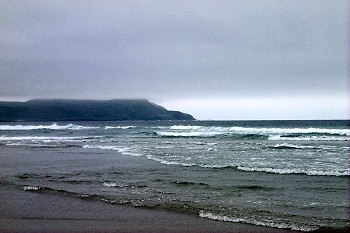 |
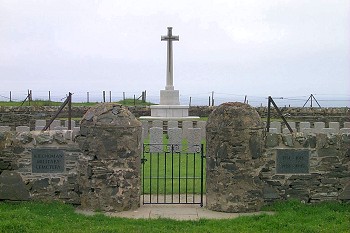 |
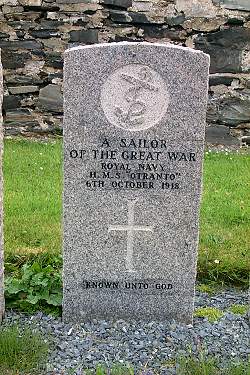 The Otranto was originally built as a passenger liner in 1909 but was requisitioned as an auxiliary cruiser and troop ship during the war. In October 1918 it was part of a convoy transporting US soldiers to Glasgow and Liverpool. On 6 Oct 1918 the Otranto was involved in a collision with the HMS Kashmir,
-> The Otranto was originally built as a passenger liner in 1909 but was requisitioned as an auxiliary cruiser and troop ship during the war. In October 1918 it was part of a convoy transporting US soldiers to Glasgow and Liverpool. On 6 Oct 1918 the Otranto was involved in a collision with the HMS Kashmir,
-> |
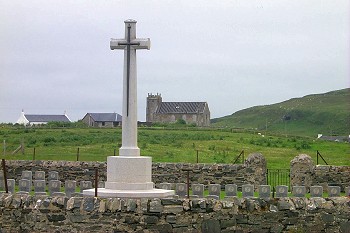 another passenger liner converted to a troop ship during a heavy storm. The Otranto was badly damaged and once the engines stopped unable to navigate. With over 1000 soldiers on board it was drifting towards the cliffs of Machir Bay while SOS signals were given on order of Captain
Davidson. They were picked up by the destroyer HMS Mounsey whose commander Lt Craven decided to go for a daring rescue: Due to the weather conditions the only possible option to save anyone was to go alongside the bigger ship and transfer another passenger liner converted to a troop ship during a heavy storm. The Otranto was badly damaged and once the engines stopped unable to navigate. With over 1000 soldiers on board it was drifting towards the cliffs of Machir Bay while SOS signals were given on order of Captain
Davidson. They were picked up by the destroyer HMS Mounsey whose commander Lt Craven decided to go for a daring rescue: Due to the weather conditions the only possible option to save anyone was to go alongside the bigger ship and transfer |
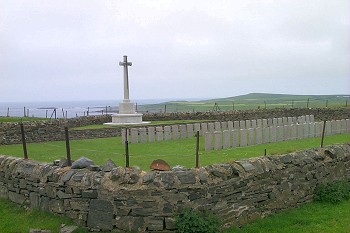 |
the crew and soldiers to the destroyer. Through skillful handling the Mounsey managed to take off several hundred soldiers and crewman in several attempts while using the lifeboats of the Otranto as fenders. Still 431 people died in the disaster and only 16 managed to swim to the shore once the Otranto sank after the Mounsey had to leave for Belfast. 75 of the victims are buried in the cemetary at Kilchoman, of which 43 are unidentified. They include the cook
and the captain, who has his own much larger gravestone.
Many thanks to Carl Satter who sent me a lot of information about the HMS Otranto from his research, the material has been very helpful to prepare this page. |
| On 5 Feb 1918 the HMS Tuscania, a troop transporter with over 2000 people on board, was torpedoed by the Germany submarine UB77 under Commander Wilhelm Meyer. Despite rescue efforts 266 soldiers drown when the Tuscania sinks 7 miles offshore of Islay, several of them when their lifeboats are struck against the cliffs of The Oa.
In 1920 the American National Red Cross erected the American Monument on the Mull of Oa in memory of those who died when the Tuscania and the Otranto sank. The memorial is inscribed with the following metaphor: "On Fame's eternal camping ground, their silent tents are spread, while glory keeps with solemn round, the bivouac of the dead" |
|
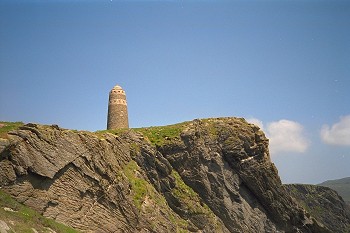 |
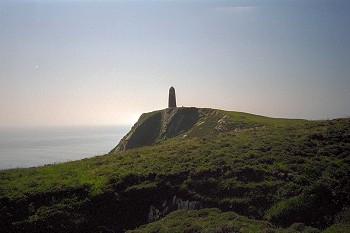 |
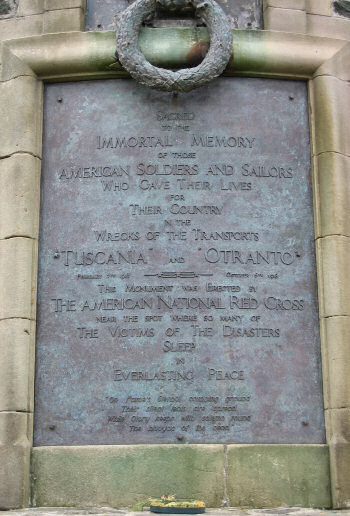 |
The full text on the plaque reads: Sacred On Fame's Eternal camping ground |
 |
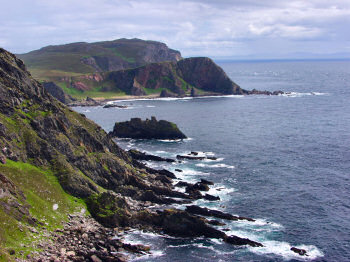 |
Further external links with information about the sinking of the Tuscania and Otranto:
|
|
 |
Back to top
Copyright © 2002-2009 Armin Grewe - About - FAQ |
 |